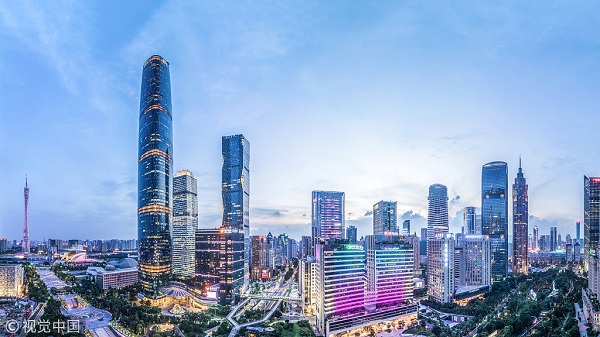Greater Bay Area to build world-class business environment


Night view of the skyline in Guangzhou, Guangdong province [Photo/VCG]
World-class bay area built on globally competitive business environment
In recent years, more and more giant projects worth more than $10 billion invested in by Fortune 500 firms have chosen the Guangdong-Hong Kong-Macao Greater Bay Area. For example, Germany-based BASF SE will build a fine chemical integration base in Zhanjiang, Guangdong province, which is the first foreign-owned project in China's heavy chemical industry; and Exxon Mobil Corporation will develop a chemical project in Huizhou, Guangdong province.
From January to July 2018, the actual use of foreign capital in Guangdong province was 88.9 billion yuan ($13.24 billion), ranking first in the country. In detail, investment from the United Kingdom, Japan and Germany has increased by 93.8 percent, 52.8 percent and 49.1 percent respectively.
Li Guanghui, deputy director of the Chinese Academy of International Trade and Economic Cooperation, noted that Guangdong has always been leading China's reform and opening-up, and Hong Kong has been rated as one of the world's most free economic entities for 23 consecutive years.
Throughout the growth of the three major bay areas in the world – New York metropolitan area, San Francisco Bay Area, and Tokyo Bay Area, the institutional factor behind their rapid development has been an international-standard business environment, said Zhu Lijie, general manager of Dragon Gate Investment Partners.
The Greater Bay Area is striving to create a globally competitive environment comparable with the three major bay areas. Since August 2017, a series of preferential measures and policies have been put forward by the Guangdong government to broaden market access, reduce firms’ operation costs and improve coordination across the Greater Bay Area. By the end of 2017, more than 10 million market entities had been registered in the province.
"Coordinated" development in the area
In May 2018, the University of Macao and Sun Yat-Sen University in Guangzhou jointly built a laboratory to strengthen research cooperation in chemical synthesis, optoelectronics and energy materials. The University of Macao also built such a cooperative laboratory with Shenzhen University, as well as establishing partnerships with Chinese tech giant Huawei. "The university will be a new platform to create new models in technological and economic cooperation," said Song Yonghua, rector of the University of Macao.
There are more and more platforms seeking high-level cooperation being established in the Greater Bay Area, including Hong Yong and Macao Youth Entrepreneurship Base, Guangdong-Macao Traditional Chinese Medicine Technological and Industrial Park, and Shenzhen-Hong Kong Cooperation Demonstration Zone.
However, what's more important is how development between Guangdong, Hong Kong and Macao can be coordinated on the basis of "one country, two systems".
Guangdong Pilot Free Trade Zone, as a bridgehead for the coordinated development of the Greater Bay Area, has gradually launched an investment management institution and a customs clearance service system in line with the international standards which were implemented in Hong Kong and Macao. Items on the negative list have been reduced to 45, and 99 percent of newly established foreign-invested firms were approved. The average customs clearance time for general cargo has been decreased by 42.6 percent.

Ships and containers at Nansha terminal, Guangzhou, capital of Guangdong province [Photo/VCG]
Against such a background, Choi Koon Shum, director of the Chinese General Chamber of Commerce, suggested that drawing on the EU's experience in eliminating differences in imports, exports, immigration, currency, law and communication between countries, a pilot mechanism for coordinated development can be pioneered in free trade zones such as Nansha, Hengqin and Qianhai to gradually achieve seamless integration with Hong Kong and Macao.
Supporting Belt and Road Initiative
The Greater Bay Area is a key supporter of the Belt and Road Initiative (BRI). In terms of infrastructure interconnection, on one hand a modern comprehensive transport system has been established in the area, closely linking Guangdong, Hong Kong and Macao. On the other hand, utilizing Hong Kong and Macao's unique location advantages, the Greater Bay Area helps to strengthen ties between China and BRI countries.

A terminal in Hong Kong. Numerous such terminals are dotted across the area. [Photo/VCG]
In addition, the Greater Bay Area also supports firms to expand markets in BRI countries. For instance, Hong Kong has signed an agreement to promote and protect investment with 20 economies including ASEAN. As a result, ASEAN is lowering investment thresholds for Hong Kong firms. Firms from the Chinese mainland could only take up to 49 percent of shares when investing in ASEAN region, while they could get 70 percent of shares if they were from Hong Kong.
Since China's reform and opening-up started in 1978, Hong Kong and Macao have always played an important role in connecting the Chinese mainland to international markets, while nowadays, with the building of the Greater Bay Area, Hong Kong and Macao are active participants and operators in the process, said Choi Koon Shum.







